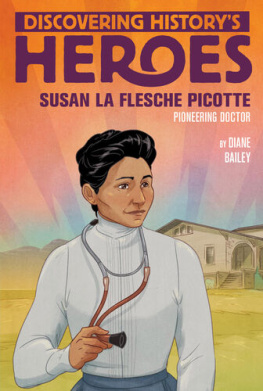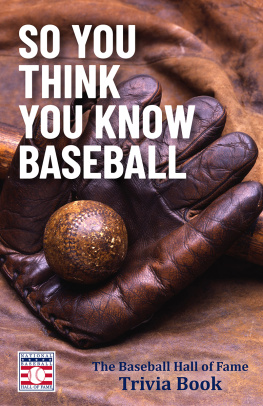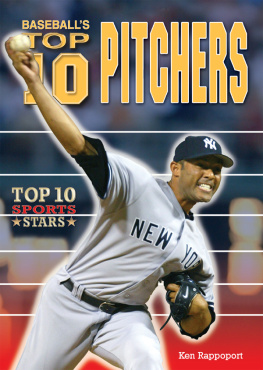Foreword
No one ever expects to pitch a perfect game. Its an extreme rarity that every pitcher dreams about, but it has only happened 20 times in the entire history of Major League Baseball. For me, it was the highlight of my professional career.
My perfect game was a total surprise to me, but I can still remember it like it was yesterday. It was Fathers Day 1964, and we were playing the Mets at Shea Stadium in the first game of a doubleheader. The weather was sunny, hot, and humidjust the kind I liked. My wife, Mary, and our daughter, Barbara, had driven to New York for the game and were in the stands watching.
During warm-ups I didnt feel particularly sharp, but in the first inning I got away with a few bad pitches and I felt like the good Lord might be smiling on me that day. I had complete command of my fastball and slider, and after the fifth inning I developed a really good curve that I could throw for a strike at any time.
As the game went on, being perfect became a mission. I was letting all my teammates know about it and trying to loosen them up on the bench. Baseball superstition demands that players in the dugout not talk about a no-hitter or a perfect game so that they dont jinx the pitcher. But I had never believed in superstitions. I kicked the foul line and broke all of the little rules that many players swear by. Plus, just three weeks earlier, I had taken a no-hitter into the eighth inning in a game against the Houston Colt .45s, but our team became so uptight about the no-hitter then that it ended up costing us the game.
I wasnt going to let that happen again. So after every inning I kept talking to my teammates in the dugout to relieve the pressure, urging them to buckle down and to stay sharp. And they did. In the fifth inning my second baseman, Tony Taylor, made an unbelievable diving stop on a hard ground ball hit to his left and from his knees threw out Jesse Gonder by a step. Dick Allen also made a sparkling play on a smash into the hole at third base to rob a sure hit.
After the game was over and the initial thrill had worn off a bit, I realized that the best part about a perfect game is that your teammates are perfect with you. In my professional career, I have never felt anything else quite like it, except maybe the elation that came when I won a seat in the U.S. Senate in 1998. But that victory took the work of so many more peoplevolunteers, supporters, and staffwhile on the diamond there were just nine of us. That made it a little more special because on that one summer day in 1964, our team was flawlessin pitching, fielding, and communicating on the fieldand the thrill that comes with working so closely, so perfectly, with your teammates is beyond words for me. Baseball might be a series of one-on-one matchups between the pitcher and the hitters, but on that day we wonand were perfectas a team.
Only a handful of pitchers have thrown perfect games, and Im very proud to be part of that group and part of this book. Sometimes a perfect game is the only great game of a pitchers career; sometimes its just another milestone in a Hall of Famers career. But that doesnt really matter. Because the thrill and emotion from a perfect game last a lifetime.
Senator Jim Bunning
7. Jim Bunning
June 21, 1964

Future senator Jim Bunning was a Phillie when he celebrated Fathers Day 1964 with a perfect performance against the Mets. Photo courtesy of AP Images
H ey, Jim Bunning! Youve just pitched the first perfect game in the National League in 84 years! And youve just become the first pitcher ever to win no-hitters in each league! Now what are you going to do?
Im going to HoJos!
Yes, thats right. After setting down 27 New York Mets on June 21, 1964, for a 60 Philadelphia Phillies victory, Jim Bunning enjoyed a sumptuous congratulatory feast at a one-star Howard Johnsons on the Jersey Turnpike. Pitch a perfect game and pass the paper napkins, please. Since Larsen made the perfect game famous, perhaps no other pitcher has enjoyed so plebeian a postgame feast. Of course, this being 1964, Bunning did get to go on The Ed Sullivan Show , the eras equivalent of doing the rounds of all the network morning shows at once and in the evening.
Much has also been made of the fact that Bunning, then the father of seven and eventually the father of nine (hey, he could field his own team!), pitched his perfect game on Fathers Day. His daughter Barbara, accompanied by his wife Mary, was the only one of the then-septet at the game, but all of the Bunning kids shared in the joy of their dads amazing accomplishment.
Not since John Ward, throwing underhand from 45 feet, had a National League pitcher gone 27-for-27. So one could argue that under current rules, Bunning was the very first National Leaguer to toss a perfecto. That Bunning created his gem against the Mets matters not; that was the major league team he was faced with, and he mowed them down like traffic cones at a driving school for the blind.
Bunning was in his first season with Philly in 1964, having been traded from the Detroit Tigers the previous off-season. He arrived as a pitcher coming off a down year, having gone 1213 in his final season with Detroit after several much more successful campaigns, including 1957, when he won 20 games. In 1958, Bunning had thrown his first no-hitter when he blanked Boston in Fenway Park 30. And in 1959 and 1960, he led the AL with, in a nice bit of statistical synchronicity, exactly 201 strikeouts each year. Heading into 1964, Bunning wanted to prove that he was not the losing pitcher of 1963 but rather the big (6'3"), hard-throwing innings-eater who had starred for the Tigers over the previous half-dozen seasons.
Helped by Bunnings 62 record through June 20, the mighty bats of Dick Allen and Johnny Callison, and solid defense, the Phillies found themselves unexpectedly in first place in late June. Bunnings performance on Fathers Day took them one giant step farther down the road to what every Phillies fan still recalls as the teams darkest hour. But lets not dwell on that now. Lets share the moment.
On June 21, the sun was shining brightly, the Phils were riding high, and Bunning was in a groove early.
In front of a boisterous Sunday-afternoon Shea Stadium crowd of 32,026, Bunning and the Phils were up 10 as he took the mound in the bottom of the first. Johnny Briggs had led off the game with a walk, gone to second on John Herrnsteins sac bunt, and scored on Allens single.
It was a nice, hot day, Bunning remembered. We spoke by phone from his office in Washington, D.C., in 2004, when he was a U.S. Senator from Kentucky. After his Hall of Fame pitching career, he became a Republican congressman from his native Kentucky and was elected a senator in 2000 (he retired from politics in 2010). It was one of those wonderful starts to a game. I got away with some pitches early. Against Jim Hickman leading off the game for the Mets, I got away with some pitches that should have been hit. But he fouled them back.
He threw me two good pitches in the first, good pitches to hit, and I fouled them off, Hickman said after the game. Then he stood out there on the mound and laughed at me! After that, I didnt see a good pitch to hit all day.
Few Phillies did, and Bunning thought from the start that that would be the case.
As the game went on, all the pitches were working well, Bunning said. The slider, curve, and fastball all got thrown to the areas I was trying to throw them to. I was ahead of all the hitters, which also made it much easier.
Also making it easier was the Phillies offense, which added another run in the top of the second. Tony Taylor led off with a walk against eventual losing pitcher Tracy Stallard. (On the Philadelphia radio broadcast, Richie Ashburn pointed out that Stallard was single and childless, putting him at what you might call a karmic disadvantage to Bunning on Dads Day.) Cookie Rojas sacrificed Taylor to second (ah, the sacrifice buntI look forward to telling my grandkids about those), from where he scored on catcher Gus Triandos double to left field.
Next page











